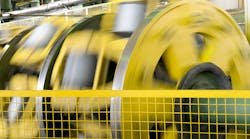In Part 1 of this series, we looked at some hazards that arise when working around rotating machinery and how to protect yourself. In Part 2, we look at five more such hazards.
Being crushed, cut, or mangled by a ram, blade, or auger
Just because rotating equipment is electrically de-energized doesn’t mean it’s safe. You could be working under a hydraulic ram that still has potential energy due to being in the wrong position and the safety clamps are not engaged. If sharp edges, such as blades and shredder “teeth,” cannot be blocked with a sheet of plywood, at least cover them with a tarp or other thick material.
Injuries from auger contact often occur due to falling into a feed chute. The most obvious solution is to walk around, not over, the chute. If this is not possible or work must be done above the chute, cover the chute with material sufficient to bear your weight — a sheet of plywood, for example. But make sure it’s secured in place.
Such barriers also prevent dropping tools, parts, or other items into the auger and, thus, eliminate yet another safety hazard that can arise once the start button is pushed.
Being burned
Rotating machinery often runs hot; you can get a touch contact burn from a motor that is under heavy load. Sometimes it’s not the machinery that poses the burn danger, but the material inside it. Hot processes, such as extrusion, can provide significant burn danger.
One solution is to wear long sleeves. But this provides the danger of being dragged into the machine if isn’t locked out the whole time you are there. If humans must work next to sources of dangerous heat, insulating materials should be permanently installed to protect them. It may also be possible to temporarily cover the hot surfaces with an insulating blanket.
In some cases, the machine will have to be artificially cooled until touch contact or ambient temperature targets are achieved. For example, to repair the feed system on an annealing oven, you may need to bring the oven temperature down via forced-air cooling over several hours.
Being dragged into a machine
The long sleeves that can protect you from a burn or electric shock can also get snagged on rotating equipment and cost you your arm. In many types of facilities, such as a power generating station, the typical maintenance tech encounters all three hazards multiple times per day.
Thus, you see electricians always wearing long-sleeved shirts with nonmetallic cuff buttons. With a tight cuff, there is little danger of being dragged into a machine. But as an additional precaution, electricians may opt to roll their sleeves up before putting their hands near the rotating parts of equipment. Obviously, a necklace is out of the question.
During the COVID-19 shutdown of 2020, hair salons and barbershops were closed or people stayed away for fear of the disease. Two male fashion trends emerged: one is a super-short DIY haircut; the other is much longer hair.
Most guys who chose the second option eventually found a need to tie their hair back to keep it out of their eyes. If the ponytail is behind you and the machine is in front of you, is there a potential danger? Perhaps not — if you always walk backward from a machine without turning your head and never turn your head when someone speaks to you. Odds are, you are not that person.
Having that ponytail in the back is similar to wearing a tie in front. Tuck it in. Your shirt collar should hold it just fine. One way we prevent tie strangulations around rotating equipment is by banning the wearing of ties around such equipment. You might want to consider this same strategy for dealing with your ponytail. In other words, snip-snip.
Getting hit by projectiles from machine structural integrity loss
Things break. In some cases, they fail spectacularly. In a coal-powered generating station, a generator’s windings came apart while it was at operating speed. The damage to that end of the turbine deck was extensive. All the damage was due to flying parts.
The most effective safety solution to this hazard is to install vibration monitoring on all rotating equipment that could present a projectile hazard. Cheap wireless sensors make this very easy to do. With a PLC or other control system, the machine can be automatically shut down when vibration crosses a predetermined threshold.
What can you do to protect yourself whether the sensors are there or not? Know where the two nearest exits are located from wherever you are. This way, you can run for one when you hear that last half a minute of rumble before the bang. If there’s no time to get to an exit from where you are, look for something solid you can use for cover.
Getting hit by work parts that ‘left their chuck’
Part of your lockout/tagout should include ensuring no work in progress is left in the machine unless there is no practical way to remove it.
Closely related to this is a method for finding lost tools. Check your tools before re-energizing. A tool count is considered the most reliable way, but if you have an organized tool pouch, pack, caddy, etc., each tool will have it specific place. Check each place as well as the work area.
This seems like quite a few things to remember to be around rotating equipment. You can boil it down to three key actions on your part: think and plan carefully before doing the job, pay attention while doing the job, and do a careful cleanup after the job.




